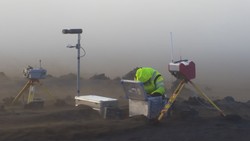Final estimates of the emissions from the Holuhraun eruption based on ground-based measurements
A new paper published lastweek in Geosciences reports that the Holuhraun eruption released the most SO2 (sulfur dioxide) of any effusive (non-explosive) eruption in the world on an annual basis since 1978, the advent of satellite monitoring of volcanic eruption clouds. The Holuhraun eruption released 16 times more SO2 (sulfur dioxide, 9.6 Mt) and almost twice as much CO2 (carbon dioxide, 5.1 Mt) as one year´s worth of anthropogenic emissions within Iceland (0.06 Mt SO2 and 3 Mt CO2 in 2015). The gases from the eruption were quite poor in the halogens HCl (hydrogen chloride, 0.1 Mt) and HF (hydrogen flouride, 0.06 Mt) which reduced the environmental impact the eruption could have had had the gases been richer in these pollutants. The collection of this eruption data has a large impact on the assessed amount of emissions from Iceland of the pollutants SO2 and CO2, as well as the other assessed gases. These pollutants are assessed by nation because of their significant impact on human health and the environment.
A team of scientists led by Dr Melissa Anne Pfeffer at the Icelandic Meteorological Office, with partners from 16 international institutions, collated all ground-based measurements of the 2014-2015 Holuhraun eruption cloud. The study recommends that a diversity of methods used to measure eruption clouds continue to be improved upon, and that additional methods be developed to improve monitoring of eruption clouds in Iceland and in other places where winter-time, with very little sunlight, and remote and dusty conditions, have a huge impact on the collection of ground-based data.
Gases released during the eruption were released from magma that erupted; from non-erupted magma; and from the Holuhraun lava field during and after emplacement. The emissions of gas from the lava field continued for 3 months following the end of the eruption. The gas emission rates reflected the deep magmatic system and also surface processes.
The concentrations of gases on the surface, which were affecting people downwind from the eruption, were not always reflecting the current conditions at the eruption site. Gases were observed to accumulate in valleys, particularly overnight, and particularly when winds were weak. It sometimes took hours of stronger winds to flush the older gases out of a region.
There was only minor tephra production, and the particles produced by the eruption had little impact on the number of particles in the air because it is so dusty around the eruption site. The dust in the area was lifted into the air because of the heat released by the Holuhraun lava field. This dust encouraged the formation of clouds that persisted over the eruption site as other clouds moved past.
In general, the start of the eruption was the strongest with the highest eruption cloud heights, and then for the duration of the eruption, until the end, the height varied mainly between 1–3 km agl. The eruption cloud height has a major influence on how much of the emitted gases people who live downwind are being exposed to.
For more information contact Dr. Melissa Anne Pfeffer, Atmospheric Volcanologist at the Icelandic Meteorological Office. melissa@vedur.is.




